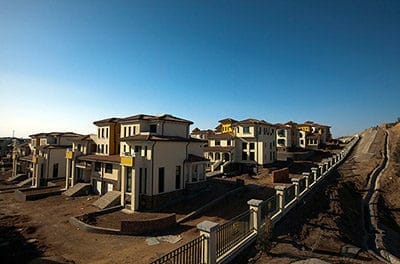
Ordos in Inner Mongolia has become a symbol of China’s overbuilding
Despite a drop in unsold inventories of property in May, the mainland still faces an uphill battle destocking millions of square meters of oversupply.This unsold overhang, coupled with diverging market performance nationwide, is leading governments in some second and third-tier cites to offer home sales incentives, while authorities in Shanghai and Shenzhen try to hold back a flood of demand.
According to figures from the National Bureau of Statistics, China was still burdened with nearly 722 million square meters of unsold property at the end of May, although this figure was down by more than 5.21 million square meters from the previous month.
Much of this supply of unwanted homes is centred in northern China’s rust belt, where cities and provinces, which boomed on heavy industry and commodities in earlier years, are now struggling to find enough residents to buy homes.
Two Speed Market Challenges Regulators
Despite the most recent month’s dip in unsold space, David Li, a director at the Center for China in the World Economy, was quoted in the People’s Daily stating that the destocking battle is far from over, as the country faces a two-speed property market.
During recent months, cities with robust local service-led economies have seen strong price growth, while manufacturing-based cities have shown weaker performance. Shenzhen and Shanghai have seen prices soar 63 percent and 34 percent in the past year respectively.
Local authorities responded to these price climbs by placing restrictions on buyer eligibility and higher down payments to ease a potential property bubble. In contrast, smaller cities facing a supply glut have explored ways to encourage sales. Li endorsed this approach, stating that “the destocking efforts should pay more attention to sales instead of prices.”
Shanxi, Qinghai and Liaoning Cities Subsidise Home Purchases
To help boost sales, authorities northern China’s Shanxi province are granting migrant workers government subsidies and tax deductions on mortgage interest, while property developers in the western province of Qinghai Province are being allowed to repurpose sites in their land banks for use in higher growth sectors such as tourism and sports.
Dalian, in Liaoning, is among the cities hit hardest by the housing slump, and the local government is attempting to counterpunch by offering cash subsidies to new home buyers and renters, as well as by lowering down payments and cutting transaction costs to spur sales.
Despite this goverment intervention, and double-digit price growth in Shenzhen and Shanghai, Dalian saw new home sales prices remain flat during the most recent month.
Dalian Facing Three Years of Unsold Homes
According to one mainland real estate services firm, it would take about three years to sell off all the new homes built in Dalian.
Data from the Ministry of Finance showed revenue from land sales in the city fell 56 percent in 2015, faster than all of the 36 regions tracked by the ministry. The city of Ningbo in Zhejiang province and the Inner Mongolia Autonomous Region in the north were the only other areas to see land revenues more than halve.
Dalian also announced plans to relocate 1.2 million rural residents in the hopes of invigorating home sales. Migrant workers have been the biggest beneficiaries of subsidies as Shandong and Sichuan provinces have offered similar cash schemes. An economist with Beijing Academy of Social Sciences stated that lower tier cities should integrate the destocking process with the country’s urbanization drive.
China has made reduction of unsold housing inventories in the nation’s lower tier cities one of its central goals for 2016, and advised local governments to respond to their property gluts as they see fit.
Leave a Reply